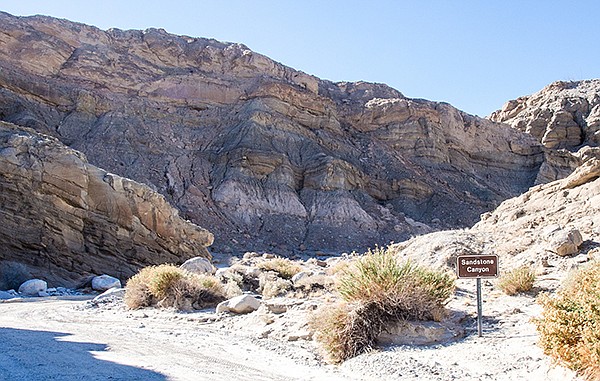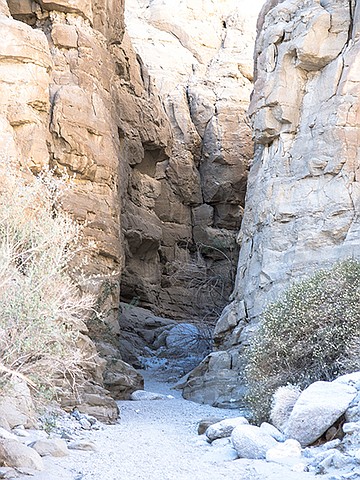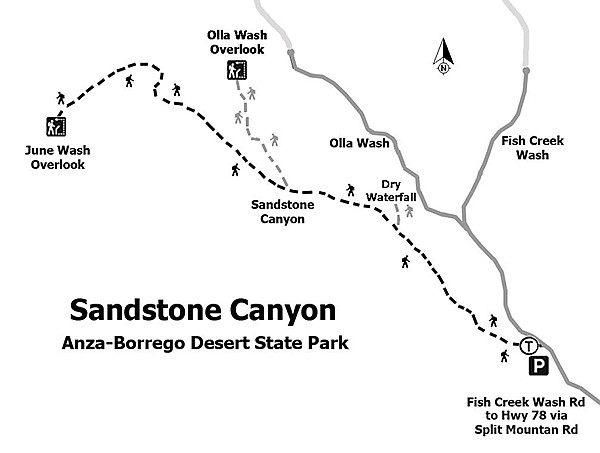 Facebook
Facebook
 X
X
 Instagram
Instagram
 TikTok
TikTok
 Youtube
Youtube


Sandstone Canyon is one of several long canyons that stretch down the flanks of the rapidly eroding Vallecito Mountains. Frequent visitors to this part of the Anza-Borrego Desert consider Sandstone Canyon to be the most dramatic of these because of the high sheer sandstone cliffs found in this narrow canyon. It is also home to bighorn sheep and two uncommon sensitive plants, Orcutt’s aster and rush milkweed, making a visit here interesting for its biology as well as its dramatic geology.
Begin hiking from your parked car at the mouth of the Sandstone Canyon even though a jeep road continues up Sandstone Canyon for another 2 miles or so. Watch for vehicles in the canyon, as it is a popular destination for off-roaders. The walls of the canyon close in rapidly as you progress west/northwest up the sandy wash. In places, sheer cliffs of layered sedimentary rock tower above the canyon floor. The layers are rocks known as fanglomerate (alluvial fan and conglomerate), mudstone and sandstone that accumulated over the course of the past 5 million years. Each layer represents mud, sand, gravel, and rocks eroded from the Vallecito Mountains. Some of the layers contain fossils that tell us about the surprising animals that lived here in the past 1.5 million years, including the ancestor of the modern camel.

This hike follows the canyon 2.4 miles up the wash where there is a narrow slot-canyon tributary on the left leading to June Wash Overlook. Take care, as the slot canyon is easily missed. The slot canyon is so narrow that it does not appear to be an important tributary. It can be followed for more than a mile. The slot canyon widens and turns toward the southwest as you progress. It also becomes steeper with more vegetation, chiefly teddy-bear cholla, silver cholla, barrel cactus, ocotillo, catclaw, and brittlebush. Keep to the left at each fork to reach the June Wash Overlook. Enjoy the view and then return the same way to your vehicle.

If time allows, there are two tributary canyons to the east to explore during the trip to the June Wash Overlook and back. The first is a small tributary located 1.2 miles into Sandstone Canyon that leads to a usually dry fall, but after a storm, water may continue to flow over it and into a small pool at its base. The second tributary is at 2.1 miles and leads to an overlook of Olla Wash. Explore these tributaries before returning again to Sandstone Canyon.
Note: Check the weather report for blowing dust at Ocotillo Wells. Usually, strong winds are not blowing in the November to May time frame.
Distance from downtown San Diego: 114 miles. Allow 3 hours driving time. From Julian, take SR 78E to Ocotillo Wells, and then turn south onto the paved Split Mountain Road (across from Benson Dry Lake). Drive about 8 miles to the end of pavement at the entrance to Fish Creek Wash on the right. Follow the wash 12.5 miles to the signed Sandstone Canyon mouth, on your left, and park. A 4WD/high-clearance vehicle is the best way to get to Sandstone Canyon, although passenger vehicles have been known to make it, with difficulty.
Hiking length: about 7 miles out-and-back.
Difficulty: Moderate with an elevation gain/loss of 1000 feet. Most of the route is an easy walk through the sandy canyon bottom, but some route finding is required once you get out of the main canyon and into the slot canyon that leads to June Wash Overlook. No facilities or water.



Sandstone Canyon is one of several long canyons that stretch down the flanks of the rapidly eroding Vallecito Mountains. Frequent visitors to this part of the Anza-Borrego Desert consider Sandstone Canyon to be the most dramatic of these because of the high sheer sandstone cliffs found in this narrow canyon. It is also home to bighorn sheep and two uncommon sensitive plants, Orcutt’s aster and rush milkweed, making a visit here interesting for its biology as well as its dramatic geology.
Begin hiking from your parked car at the mouth of the Sandstone Canyon even though a jeep road continues up Sandstone Canyon for another 2 miles or so. Watch for vehicles in the canyon, as it is a popular destination for off-roaders. The walls of the canyon close in rapidly as you progress west/northwest up the sandy wash. In places, sheer cliffs of layered sedimentary rock tower above the canyon floor. The layers are rocks known as fanglomerate (alluvial fan and conglomerate), mudstone and sandstone that accumulated over the course of the past 5 million years. Each layer represents mud, sand, gravel, and rocks eroded from the Vallecito Mountains. Some of the layers contain fossils that tell us about the surprising animals that lived here in the past 1.5 million years, including the ancestor of the modern camel.

This hike follows the canyon 2.4 miles up the wash where there is a narrow slot-canyon tributary on the left leading to June Wash Overlook. Take care, as the slot canyon is easily missed. The slot canyon is so narrow that it does not appear to be an important tributary. It can be followed for more than a mile. The slot canyon widens and turns toward the southwest as you progress. It also becomes steeper with more vegetation, chiefly teddy-bear cholla, silver cholla, barrel cactus, ocotillo, catclaw, and brittlebush. Keep to the left at each fork to reach the June Wash Overlook. Enjoy the view and then return the same way to your vehicle.

If time allows, there are two tributary canyons to the east to explore during the trip to the June Wash Overlook and back. The first is a small tributary located 1.2 miles into Sandstone Canyon that leads to a usually dry fall, but after a storm, water may continue to flow over it and into a small pool at its base. The second tributary is at 2.1 miles and leads to an overlook of Olla Wash. Explore these tributaries before returning again to Sandstone Canyon.
Note: Check the weather report for blowing dust at Ocotillo Wells. Usually, strong winds are not blowing in the November to May time frame.
Distance from downtown San Diego: 114 miles. Allow 3 hours driving time. From Julian, take SR 78E to Ocotillo Wells, and then turn south onto the paved Split Mountain Road (across from Benson Dry Lake). Drive about 8 miles to the end of pavement at the entrance to Fish Creek Wash on the right. Follow the wash 12.5 miles to the signed Sandstone Canyon mouth, on your left, and park. A 4WD/high-clearance vehicle is the best way to get to Sandstone Canyon, although passenger vehicles have been known to make it, with difficulty.
Hiking length: about 7 miles out-and-back.
Difficulty: Moderate with an elevation gain/loss of 1000 feet. Most of the route is an easy walk through the sandy canyon bottom, but some route finding is required once you get out of the main canyon and into the slot canyon that leads to June Wash Overlook. No facilities or water.